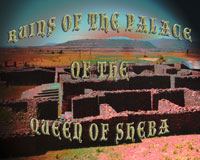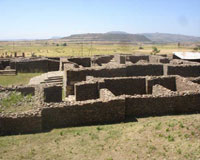Suzanne Treister
Ruins of the Palace of the Queen of Sheba
Video 2008/9
 |
 |
 |
Ruins of the Palace of the Queen of Sheba resembles a non-interactive video game demo, set within Dongar, the legendary 50 room palace of the Queen of Sheba, located on the outskirts of the ancient Ethiopian city of Axum.
The work uses original footage shot at Dongar. Freeze-frame pauses are inserted at intervals into the footage during which gunshots and other sounds are heard, as if fired by the player or from an invisible enemy. The sound effects are created from edited audio clips from the original footage.
BACKGROUND:
Dongar was discovered in 1950 and many questions surround its construction.
Despite local mythology it has been doubted that the Queen of Sheba actually
inhabited the palace. The french archaeologist Francis Antrey, who excavated
the site in 1952 (but never published the bulk of his findings) concluded
that the palace was most probably built in the 7th century AD. More recent
excavations and carbon dating tests indicate that the palace may in fact
date to the pre-Christian era. In spring of 2008 Prof. Dr. Helmut Ziegert
of the University of Hamburg published a claim, based on his recent excavations,
that the real 10th century palace of the Queen of Sheba lies underneath
the ruins of Dongar. On the opposite side of the road to the palace is
a stelae field in which the largest stele is traditionally believed to
mark the grave of Makeda, the Queen of Sheba.
The elusive history of the Queen of Sheba is immortalised in the world's great religious works, among them the Hebrew Bible and the Muslim Koran. She also appears in Turkish and Persian painting, in Kabbalistic treatises, and in medieval Christian mystical works, where she is viewed as the embodiment of Divine Wisdom and a foreteller of the cult of the Holy Cross. In Africa and Arabia her story is still told to this day.
The tales of Solomon and the Queen of Sheba have provided the founding myths for the modern states of Israel and Ethiopia.The first appearance of the tale of the Queen of Sheba's visit to King Solomon is a short narrative in the Old Testament.
And when the Queen of Sheba heard of the fame of Solomon concerning the name of the LORD, she came to prove him with hard questions. And she came to Jerusalem with a very great train, with camels that bore spices, and very much gold, and precious stones: and when she was come to Solomon, she communed with him of all that was in her heart. And King Solomon gave unto the Queen of Sheba all her desire, whatsoever she asked, beside that which Solomon gave her of his royal bounty. So she turned and went to her own country, she and her servants. (I Kings 10 v.1-13)